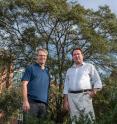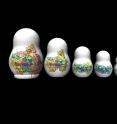Looking back 3.8 billion years into the root of the 'Tree of Life'
NASA-funded researchers at the Georgia Institute of Technology are tapping information found in the cells of all life on Earth, and using it to trace life's evolution. They have learned that life is a master stenographer - writing, rewriting and recording its history in elaborate biological structures. Some of the keys to unlocking the origin of life lie encrypted in the ribosome, life's oldest and most universal assembly of molecules. Today's ribosome converts genetic information (RNA) into proteins that carry out various functions in an organism. But the ribosome itself has changed over time. Its history shows how simple molecules joined forces to invent biology, and its current structure records ancient biological processes that occurred at the root of the Tree of Life, some 3.8 billion years ago.
By examining variations in the ribosomal RNA contained in modern cells, scientists can visualize the timeline of life far back in history, elucidating molecular structures, reactions and events near the biochemical origins of life.
"Biology is a great keeper of records," said Loren Williams, a professor in the Georgia Tech School of Chemistry and Biochemistry, and principal investigator for the NASA Astrobiology Institute's Georgia Tech Center for Ribosome Adaptation and Evolution from 2009-2014. "We are figuring out how to read some of the oldest records in biology to understand pre-biological processes, the origin of life, and the evolution of life on Earth."
The study is scheduled to be reported November 30 in the Early Edition of the journal Proceedings of the National Academy of Sciences.
Like rings in the trunk of a tree, the ribosome contains components that functioned early on in its history. The center of the trunk records the tree's youth, and successive rings represent each year of the tree's life, with the outermost layer recording the present. Just as the core of a tree's trunk remains unchanged over time, all modern ribosomes contain a common core dating back 3.8 billion years. This common core is the same in all living organisms, including humans.
"The ribosome recorded its history," said Williams. "It accreted and got bigger and bigger over time. But the older parts were continually frozen after they accreted, just like the rings of a tree. As long as that tree lives, the inner rings will not change. The very core of the ribosome is older than biology, produced by evolutionary processes that we still don't understand very well."
While exploiting this record-keeping ability of the ribosome reveals how biology has changed over time, it can also point to the environmental conditions on Earth in which that biology evolved, and help inform our search for life elsewhere in the Universe.
"This work enables us to look back in time past the root of the tree of life - the ancestor of all modern cells - to a time when proteins and nucleic acids had not yet become the basis for all biochemistry," said Carl Pilcher, interim director of the NASA Astrobiology Institute. "It helps us understand some of the earliest stages in the development of life on Earth, and can guide our search for extraterrestrial environments where life may have developed."
By rewinding, reverse engineering, and replaying this ancient ribosomal tape, researchers are uncovering the secrets of creation and are answering foundational, existential questions about our place in the Universe.
By studying more additions to the ribosome, the research team - with key contributions by Georgia Tech Research Scientist Anton Petrov - found "molecular fingerprints" that show where insertions were made, allowing them to discern the rules by which it grew. Using a technique they call the Structural Comparative Method, the researchers were able to model the ribosome's development in great detail.
"By taking ribosomes from a number of species - humans, yeast, various bacteria and archaea - and looking at the outer portions that are variable, we saw that there were very specific rules governing how they change," said Williams. "We took those rules and applied them to the common core, which allowed us to see all the way back to the first pieces of RNA."
Some clues along the way helped. For instance, though RNA is now responsible for creating proteins, the very earliest life had no proteins. By looking for regions of the ribosome that contain no proteins, the researchers could determine that those elements existed before the advent of proteins. "Once the ribosome gained a certain capability, that changed its nature," Williams said.
While the ribosomal core is the same across species, what's added on top differs. Humans have the largest ribosome, encompassing some 7,000 nucleotides representing dramatic growth from the hundred or so base pairs at the beginning.
"What we're talking about is going from short oligomers, short pieces of RNA, to the biology we see today," said Williams. "The increase in size and complexity is mind-boggling."
The researchers obtained their ribosomes from structure and sequence databases that have been produced to help scientists identify new species. Ribosomes can be crystallized, which reveals their three dimensional structures.
Beyond understanding how evolution played out over time, this knowledge of the ribosome's development could have more practical modern-day health applications.
"The ribosome is one of the primary target for antibiotics, so understanding its architecture and consistently throughout biology could be of great benefit," said Williams. "By studying the ribosome, we can start thinking about biology in a different way. We can see the symbiotic relationship between RNA and proteins."
As a next step, Williams and colleagues are now using experiments to verify what their model shows.
"We have a coherent and consistent model that accounts for all the data we have going all the way back to a form of biology that is very primitive compared to what we have now," Williams explained. "We plan to continue testing the predictions of the model."
Source: Georgia Institute of Technology
Other sources
- Looking back 3.8 billion years into the root of the 'Tree of Life'from PhysorgMon, 30 Nov 2015, 22:21:11 UTC
- Looking Back 3.8 Billion Years Into the Root of the 'Tree of Life'from Science DailyMon, 30 Nov 2015, 20:50:22 UTC
- Looking Back 3.8 Billion Years Into the Root of the "Tree of Life"from Newswise - ScinewsMon, 30 Nov 2015, 20:21:06 UTC

